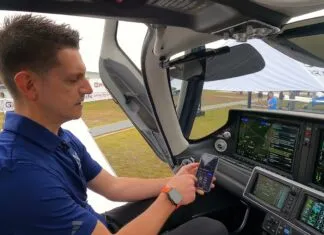There are so many headsets on the market today-ANRs, passives, in-the-ear, featherweight designs-that we often wonder if there are enough buyers to keep all of the companies in business. And even if there are, what distinguishes one headset from another sufficiently to choose it? There’s no simple answer. In the past, weve evaluated headsets purely on a subjective basis and for this review,
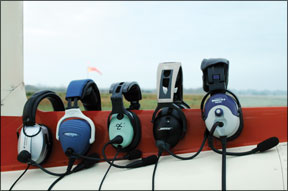
were doing that again. But this time, we also subjected the headsets to a thorough battery of audio laboratory testing.
Why? Although lab test results don’t always correlate with perceived performance, they do shed a bright light on what manufacturers consider important in designing their products. Combined with in-the- cockpit trials, technical tests give a more balanced view of how we’ll headsets actually perform.
To accomplish this testing, the audio lab at Plantronics, Inc. in Santa Cruz, California, was made available to us. Plantronics has been a leading maker of telecommunications headsets since it was founded in 1961. Because Plantronics has no representation in the around-the-ear GA headset market, its a neutral party by our estimation.
With the help of senior product engineer Dr. Nirmala Ganapathy, principal engineer
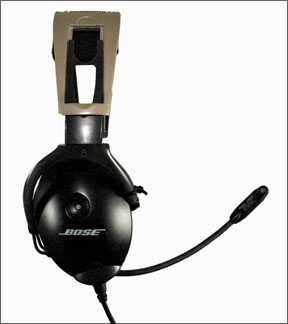
200
Steve Graham, technical associates Dan Sellings and Robert Cuneo, and senior technician Tom Trumbell, we performed an exhaustive suite of tests measuring audio performance, noise suppression and susceptibility to outside electromagnetic interference (EMI). We particularly want to thank Dr. Ganapathy for her technical guidance and substantial effort extracting the data into a publishable summary.
For this article, were reporting on only a selection of upmarket ANR headsets. Before you ask why we didnt consider all of them, we’ll answer: Space and budget. There are too many headsets to consider testing them all, so weve selected representative ANR products. In a future report, we’ll look at passive products.
All of the headsets reviewed here were provided by Gulf Coast Avionics on a loaner basis. Gulf Coast made only one stipulation: They wanted us to also test their economy ANR, which resides at a price point lower than the headsets in this group. In addition to the lab test, we conducted an in-flight focus group test of most of the products. The results of that trial can be found on page 8.
Test Summaries
The sidebar on page 6 describes the tests in detail and provides results. In making sense of these tests, it helps to understand some underlying principles. In telecommunications, intelligibility of speech is the goal; fidelity is not. Thus, the audiophile standards you may be familiar with don’t necessarily apply. The principles and measurements used are the same, of course, but the conclusions from those
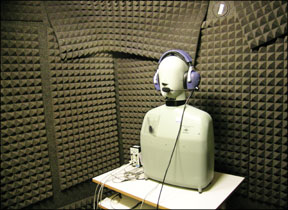
measurements don’t transfer we’ll between the telecommunications and the audiophile worlds. In some cases, audiophile-level performance could provide poorer intelligibility.
Our tests employed three anechoic chambers or soundproof booths. The first measured audio performance-frequency response, distortion and so on. The second measured external noise suppression and the third measured EMI immunity. For the audio and noise tests, the headset was mounted on HATS, a Head-And-Torso-Simulator with calibrated microphones in the “ears” and a calibrated speaker in the “mouth.”
We began by testing the ANR headsets at full volume, but we found distortion in some models-the David Clark X-11 in particular – at their highest volume, so we ran the tests on all the ANR headsets with the volume controls at half. The tests were run on each ear and the results were averaged except on the X11, Flightcom Denali and the GCA ANR II.
On these headsets, the individual earphone volume controls did not track well. In the same physical position, the volume was different on each side and this caused some testing anomalies. So for these headsets, we only reported the better side.
Our evaluation formed a subset of the tests specified by the headset TSO. Plantronics doesnt manufacture circumaural aviation headsets-that is, those that fit around the ear-so this helped us assure impartiality. In addition, we observed and assisted in the actual testing so were confident that the results are accurate, complete and unbiased. To our knowledge, no other independent aviation headset evaluation has employed such thorough quantitative testing. What follows are lab performance summaries for each model we tried.
Bose Headset X
Well known for its line of upscale audio products, Bose stunned the aviation world in 1989 with the first practical noise canceling headset. It sold for $965 at a time when a good passive headset could be bought for $180. Interestingly, now evolved through several iterations, the Bose Headset X still sells for about the same price: $995. (Adjusted downward for inflation since 1989, the equivalent price is about $600.)
The Bose is known for its lightweight construction, with small earcups and a magnesium headband that provides just enough clamping pressure for ANR, but no passive help to speak of. The soft gel earseals are much improved over the early versions, although theyre still a bit sticky in hot weather. The headset can run on battery or ships power.
Overall, the Bose performed best across the range of our testing. It exhibited good earphone frequency response and although the mic was among the flattest of all we tested, it did have some swings in the lower frequencies. Earphone and microphone distortion were the lowest tested-all good-and it had excellent noise rejection and good EMI immunity.
David Clark X11
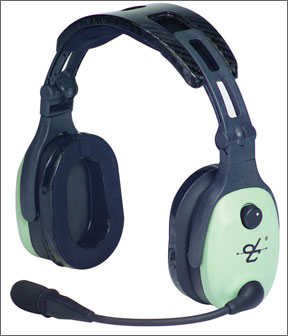
200
Before Bose even thought about aviation headsets, David Clark had been in the business for years and it still makes what many consider to be the best passive headsets in aviation. These rock-solid designs remain the standbys for many pilots, despite a flood of cheap knockoffs.
With Bose having set the standard, David Clark was forced to respond with ANR designs of its own. Initially, these proved somewhat heavy and with the stiff clamping pressure characteristic of passive designs. The X11, priced at $759 discounted, is Clarks latest iteration of ANR and also its lightest yet. The earcups are small and the lightweight carbon fiber headband yields perceived clamping pressure as light or lighter than the Bose.
In the lab, the X11 performed adequately on the audio tests, but wasnt exceptional. Frequency response of the earphones was good, but the mic showed a bit more low-frequency rolloff than the others. (Rolloff means a measureable drop in response.) The average mic distortion was fine, but the peak mic distortion was
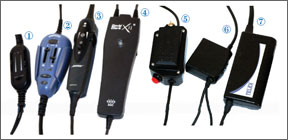
somewhat high. Although exhibiting the worst earphone-to-mic coupling, the X11 was still acceptable. Only the highest frequencies showed coupling above our threshold and we don’t think that would be noticeable in use. But the X11s noise suppression and EMI results were disappointing, especially during the inflight testing.
FlightCom Denali
Flightcom got its start the way many aviation businesses have. Its founder was taking flying lessons in the early 1980s and felt he wasnt learning due to the cockpit din. So he started a company to build headsets to address that problem. Today, Flightcom has a line of GA headsets, military products and intercoms. The Denali is Flightcoms top-of-the-line ANR.
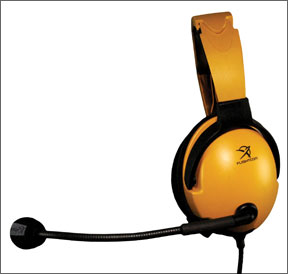
200
Made of stout plastic with a padded band and roundish earcups, its available in yellow or blue for about $599. Its also sold in a panel-power version, in addition to portable power from a 9-volt battery. At 11.1 ounces, the plastic construction makes it one of the lightest headsets we tried.
Performance-wise, the Denali was so-so. The earphone response was similar to most of the others, but it tended to roll off a bit more on the low end and was more accentuated than the others at the top end. Mic response was average. Earphone distortion was average while the mic distortion was good. The Denali was disappointing on the noise suppression and EMI tests when compared to the Bose or like-priced products.
LightSPEED Thirty-3G
If any company has sought to challenge Bose as the King of ANR, its LightSPEED, which declares itself to be the number one seller of ANR since it entered the market
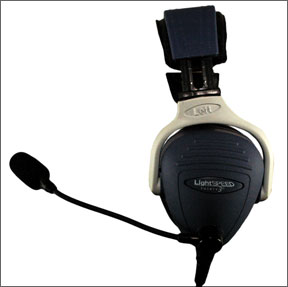
200
in 1996. LightSPEED manufactures nearly a dozen different passive, active and lightweight models, all priced at the lower to middle end of the market.
We picked the model Thirty 3G, at $599, as representative of the line. Since its inception, LightSPEED has pursued an inexpensive, plastic-intensive construction mode that yields a light, comfortable headset at the expense of durability, in our view. LightSPEEDs have expansive earcups with generous foam seals that are comfortable in hot weather, but more susceptible to degradation with time and use, in our experience. LightSPEEDs free repair policy takes the sting off that.
The Thirty 3G held its own performance wise. Earphone frequency response was adequate but not quite up to the others, with more low frequency rolloff and more high frequency accentuation. Mic response was good and distortion figures were very good with the earphone distortion second only to the Bose. But mic noise rejection was poor, while the ANR circuitry worked we’ll both in the lab and the airplane. EMI performance was second only to the Sennheiser.
GCA ANR II
As noted, we wouldnt have necessarily included this headset in our evaluation because its out of the general price range. As large mail/Web companies occasionally do, Gulf Coast commissioned its own house brand and the GCA ANR II is the result. This headset is a bit of a hybrid. Its really just a passive LightSPEED
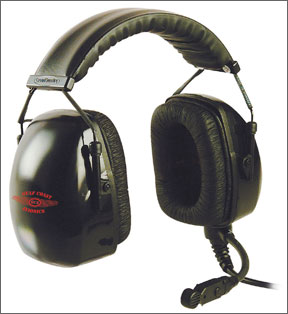
200
QFR, but with some basic ANR circuitry added. The earcups are of hard plastic and largish and it has a padded wireframe headband that provides the moderate clamping pressure a passive headset needs.
Because it started life as an inexpensive passive, the GCA ANR II turns out to be-at $249-an inexpensive active noise canceling headset. It was the hands down best performer for passive attenuation-no surprise there. Its active performance was generally good, with both good earphone and microphone frequency response. Earphone distortion was the highest tested while mic distortion was good. Noise suppression was marginal and the EMI susceptibility was the highest tested.
Sennheiser HMEC 460
Sennheiser can be thought of as a German version of Bose-not the headset, but the company. Its origins date to 1945 and its core strengths are microphone and wireless technology for the consumer and audio studio industries. Like Bose, its audio products are diversified, but unlike Bose, it has more than one aviation headset in its line.
For this review, we tested Senn-heisers latest high-end product, the HMEC460 which, at $789, is at a price point above the rest of the pack and just a bit below
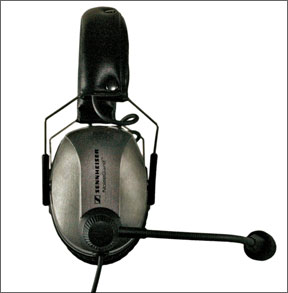
200
the Bose. In our view, were not sure the price is justified when all the results are in. The headset is competently constructed, with light clamping force and comfortable leatherette-covered ear seals and has a generous 10-year warranty.
This headset performed on par in both frequency response tests, with the mic showing a slightly increased rolloff at the high- and low-end. Earphone distortion was excellent while the mic distortion wasnt quite as good. Like the LightSPEED, its mic noise cancellation was poor, but ANR performance was good. One surprise: the HMEC460 led the pack in EMI immunity. Clearly, Sennheiser paid attention to this. It also has a unique automuting feature for music input. We couldnt test it in the aircraft because we had to return the lab demo model before the focus group trial (left) was done.
Telex Stratus 50-D
Telex is one of the old standbys in aviation headsets, competing for many years with David Clark in the passive headset market and early on in the ANR market as well. Telex is by far the most diversified of all the companies plying the aviation trade. It makes everything from antennas to CB microphones to paging systems. It

0)]currently has six models in its general aviation line, with the Stratus 50 Digital at the top of line. Typical discounted retail is $695.
The Stratus is without a doubt the largest and most robust of all the headsets we tried. If a Russian tank commander wanted an ANR headset, this would be it. The earcups are large and the earseals thicker even than the LightSPEED. The Stratus doesnt quite extend beyond your shoulders, it just feels like it.
Performance in the lab was mixed and hardly exceptional. Earphone frequency response was the best from about 700 to 3000 Hz, but exhibited a significant difference between the ears below that, with one ear dropping off rather badly and the other exhibiting jagged performance in the lower frequencies. This may explain the headsets hollow (but clear) sound in the airplane. Mic response was average, showing a bit of a peak in the 2 to 3 kHz range. Both earphone and microphone distortion were among the highest. Mic noise cancellation was poor with average ANR performance and EMI susceptibility.
Conclusion
From these tests, we learned that headset design is a question of balancing or optimizing a pot full of variables to match ANR performance to mechanical design. Who does that best, wins. And Bose wins. Our lab tests showed that across a range of variables, Bose got the most right and the least wrong. Its strong nearly everywhere and not noticeably weak anywhere.
When our focus panel went flying, everyone wanted to wear the Bose. From a purely technical standpoint, the second and third-place finishers are Sennheiser and LightSPEED, in that order. Although we found the Sennheisers construction clunky, it did we’ll in the lab. The LightSPEED simply represents the best combination of low price and good technical performance, in our estimation.
In the end, however, the final test in headset selection is buying and flying, as noted in the focus group report. Although none of our four-person panel disliked the Bose, opinions diverged on what was next best. Advice: Buy from a vendor who will allow you to return a headset that doesnt fit or that you don’t like.
In the end then, our recommendations are thus: Bose Headset X if price is no object, followed by either the LightSPEED Thirty 3G or the Telex Stratus, then the Sennheiser HMEC 460. In our view, the Sennhesier would rate better if it werent so expensive. Its $200 more than the LightSPEED, but we didnt think it was $200 better in performance, at least in the lab. The GCA ANR II is an excellent bargain for a second or backseat headset, but wouldnt be our top choice for the left seat.
Frank Bowlin is an airline pilot and aircraft owner and a regular contributor to Aviation Consumer.


